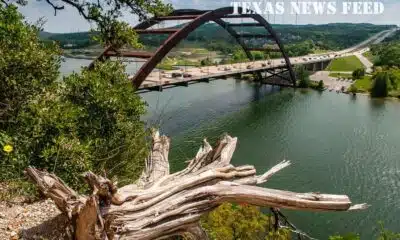News from the South - North Carolina News Feed
The John B. Lewis soccer fields look like they survived Helene. But what’s the long-term solution to this flood-prone recreational area? • Asheville Watchdog
You’ve got to hand it to the John B. Lewis Soccer Complex in east Asheville — it is one tough customer.
I drove by the beloved recreational soccer complex last week, and I was amazed at what I saw: Work crews had carefully removed a couple of feet of silt off a couple of the fields, revealing crisp green artificial turf beneath.
If you’re familiar with JBL, you probably know that it’s flooded multiple times in the past two decades, including a whopper in 2004 when the place was set to open but was inundated with water and silt. Another doozy struck in 2018. And another in 2019.
So after Helene laid waste to Swannanoa, Biltmore Village and pretty much anything along the Swannanoa River, I just assumed the river-adjacent JBL complex got erased.
When I drove into the complex on Azalea Road off of Swannanoa River Road, it still looked like a war zone. Trees and debris were strewn about in the parking lots and the borders of the fields. Half of the sizable bridge leading into Rec Park and the WNC Nature Center remains missing, until you notice it parked along the far side of the river like a broken-down concrete raft.
A squadron of dump trucks and numerous pieces of heavy equipment were removing silt and debris, while a small skid steer loader zoomed back and forth on one field carefully scraping up mud.
Beneath it, lovely green artificial turf! Honestly, to my untrained eye, the fields looked remarkably good, considering they were probably under 20 feet of water Sept. 27.
Jumping to conclusions, I thought, “Damn, I bet the city can bring this complex back to life.”
The silt actually helped this time
I also realized I may be getting ahead of myself, so I reached out to Chris Corl, the city of Asheville’s director of community and regional entertainment facilities. Asheville owns the complex, while the Asheville Buncombe Youth Soccer Association (ABYSA) runs the leagues that play there, serving about 6,500 youth players and 2,000 adults.
Corl said the debris contractor is working for the U.S. Army Corps of Engineers. The JBL cleanup started Feb. 2, so I caught the work pretty early on.
“As of February 5, the majority of field 4 had been unearthed,” Corl told me via email. “Work is expected to take three to four weeks at least to clear off the fields and finish debris removal throughout the park.”
I asked for a breakdown on cost, but Corl said the debris removal is part of the master contract for the entire city, so he couldn’t break it out easily.
So, can these fields be saved?
“At first glance, field 4 does seem to be salvageable, however, it, nor the remaining three fields that have yet to be unearthed have been assessed,” Corl said.

He said the city held a meeting at the fields Feb. 5 with ABYSA and its turf contractor, Astroturf, to discuss Astroturf’s initial reaction to the field condition and talk about potential next steps.
“We intend to have the fields assessed after debris cleanup is completed to understand potential restoration costs and timelines,” Corl said.
A city official told me last week that because the debris removal is being handled by the U.S. Army Corps of Engineers, it’s not costing the city anything yet. When it comes to rebuilding, FEMA likely will pay 90 percent, and the city hopes the state will pay the remainder.
All that silt I mentioned may have actually been a saving grace.
“It seems that at least for field 4, the turf managed to survive due to the incredible amount of silt,” Corl said. “The silt in some places was as much as three feet thick and acted as an insulator from the later debris, which included trees, vehicles, portions of buildings, etc. One of the few cases where all of the silt was a good thing.”
A fascinating history, filled with flooding
When I say these fields have a history of flooding, I’m not exaggerating. Back in the spring of 2019, I wrote a column for the Citizen Times titled, “Time to scrap JBL soccer fields? Not so fast…”
I noted then that JBL was slated to reopen after being closed for almost a year because of another flood the year before. The contractors were just finishing up with a $1.1 million silt and mud cleanup from the 2018 flood when the 2019 deluge happened.
By the way, the city had to pick up $875,000 of that cost, ABYSA $200,000, a formula that was tweaked to be more in the city’s favor afterward.

The land that JBL sits on has a fascinating history, as it was once part of Lake Craig, a recreation spot dating to the early 20th century. The Black Mountain News recently carried a good historical piece on the property, noting, “In 2002 the city of Asheville bought the land where Lake Craig once was to build new soccer fields for $1.7 million dollars as a part of the new Azalea Park project. The new soccer complex was named after the 16-year-old Asheville High School soccer player, John B. Lewis, who died in a car accident in 1998.”
Lewis’s parents contributed $350,000 for the project, the paper reported.
“Unfortunately, when Hurricane Frances hit WNC in 2004, the turf waiting to be installed was lost to the flooding and delayed the opening,” Black Mountain News wrote. “Since the completion of the John B. Lewis Soccer Complex the soccer fields have flooded over eight times.”
Told you the site has some flooding issues.
Mayor wants to see fields open ‘as soon as possible’
Asheville Mayor Esther Manheimer told me via email that the fields are enjoyed by thousands of people and contribute to the well-being of the community.

“I hope to see these fields restored and made available for recreation as soon as possible,” Manheimer said. “Of course, there are many city recreational amenities that are in need of repair, and staff is working through this long list, project by project. It is no small undertaking.”
Mike Rottjakob, executive director of ABYSA, told me Friday that he’s tentatively optimistic the fields can be brought back to life. He noted that key infrastructure, including the underlying material beneath the turf, as well as the concrete curbing and the base around the fields, remains intact, according to an Astroturf engineer who surveyed the damage.
Rottjakob also pointed out the fields are a key part of the quality of life here, as well as an economic engine. He said in the fiscal year ending in 2023, the JBL complex and the tournaments it hosts were responsible for generating 20,000 hotel room nights.
“You can’t separate the quality of life from the economic impact, because both of them go hand in hand,” Rottjakob said.
Rottjakob is not saying 100 percent the complex must be reopened. He realizes people will call for moving it elsewhere, or at least taking a long hard look at the long-term viability of the place.
I asked him if he wants to see the fields reopen soon.
“That’s a really tough question to ask me, because it’s going to be a conversation between the city and ABYSA,” Rottjakob said. “It’s a very valid question about whether we should rebuild there or not, and we certainly understand that when you print your column, that there’s going to be people saying, ‘What are they thinking?’”

I suspect some folks will be saying, ‘Hey, if we can get FEMA and the state to clear the fields and get them reopened this time, we certainly should do it.’ But the city has a lot to think about with rebuilding places like JBL, not to mention the River Arts District and Biltmore Village.
Because we’re going to see more flooding.
As I mentioned in a recent column, several early studies have suggested climate change boosted Helene’s rainfall amounts by anywhere from 10 to 50 percent. Warmer temperatures, particularly in the Gulf of Mexico, mean storms pick up more moisture and clouds hold more water, and that means we can expect more heavy rainfall events.
They likely won’t be whoppers like Helene, which was a 1,000-year rainfall event. But riverside parks like JBL will flood again, and taxpayers must decide if they want to keep shelling out big bucks every few years to scrape off the mud.
In 2019, Rottjakob told me he shared “taxpayers’ concerns about the out of control cost of the 2018-19 clean-up project, but the idea that the city built this park in a flood plain, with the hopes that it just wouldn’t flood, makes no sense.”
“In fact, flood mitigation work completed by the city in 2015, was designed to make the soccer fields flood more frequently to protect Biltmore Village,” Rottjakob continued then, noting that other city parks are built in floodplains and require cleanups.
Moving fields could be ‘cost prohibitive’
Corl says it’s too early to tell what any kind of permanent fixes at JBL may look like, or if they make sense.
“There have been numerous times in the past that the question of moving these fields elsewhere has come up,” Corl said. “Each time, unfortunately, it was cost-prohibitive to do so. We are currently discussing options internally, and with ABYSA.”
While it’s too early to say what the best path forward will be, Corl said “it does seem to be the case that our best opportunity to utilize FEMA funding towards replacement is to rebuild in place, if we are able to do so within the constraints of the site, and funding opportunities.”
Soccer is crazy popular around here, and JBL — when it’s not flooded — is a great facility in a picturesque spot. It would just be nice if the Swannanoa would stop flooding.
“We’re all aware of the need to increase our current number of functional fields within our community as soon as possible and are working closely with ABYSA to find the best path forward and a proper timeline,” Corl said. “For now, the best course of action is wait and see, hopefully we’ll have good news on the field assessments once completed after debris removal.”
Some may argue it’s throwing good money after bad. Others may say it’s worth it to provide kids and adults with a top-notch soccer facility.
I think it’d be great if the city and ABYSA could magically find 30 or 40 relatively flat acres in a nice dry area with no potential of flooding, but it’d also be great if I could find $30 million that fell out of my downspout.
Asheville has a lot of hard decisions to make these days about what should and shouldn’t be rebuilt, and what to do with JBL is among them. I’d like to see those turf assessments and potential cost figures, but I’d certainly lean toward reopening it this go-round, especially if the federal and state dollars pay the tab.
But the long run is the big question, and I don’t have the answer to that conundrum. Do you?
Asheville Watchdog is a nonprofit news team producing stories that matter to Asheville and Buncombe County. John Boyle has been covering Asheville and surrounding communities since the 20th century. You can reach him at (828) 337-0941, or via email at jboyle@avlwatchdog.org. The Watchdog’s local reporting is made possible by donations from the community. To show your support for this vital public service go to avlwatchdog.org/support-our-publication/.
Related
The post The John B. Lewis soccer fields look like they survived Helene. But what’s the long-term solution to this flood-prone recreational area? • Asheville Watchdog appeared first on avlwatchdog.org
News from the South - North Carolina News Feed
White House officials hold prayer vigil for Charlie Kirk
SUMMARY: Republican lawmakers, conservative leaders, and Trump administration officials held a prayer vigil and memorial at the Kennedy Center honoring slain activist Charlie Kirk, founder of Turning Point USA. Kirk was killed in Utah, where memorials continue at Utah Valley University and Turning Point USA’s headquarters. Police say 22-year-old Tyler Robinson turned himself in but has not confessed or cooperated. Robinson’s roommate, his boyfriend who is transitioning, is cooperating with authorities. Investigators are examining messages Robinson allegedly sent on Discord joking about the shooting. Robinson faces charges including aggravated murder, obstruction of justice, and felony firearm discharge.
White House officials and Republican lawmakers gathered at the Kennedy Center at 6 p.m. to hold a prayer vigil in remembrance of conservative activist Charlie Kirk.
https://abc11.com/us-world/
Download: https://abc11.com/apps/
Like us on Facebook: https://www.facebook.com/ABC11/
Instagram: https://www.instagram.com/abc11_wtvd/
Threads: https://www.threads.net/@abc11_wtvd
TIKTOK: https://www.tiktok.com/@abc11_eyewitnessnews
News from the South - North Carolina News Feed
Family, friends hold candlelight vigil in honor of Giovanni Pelletier
SUMMARY: Family and friends held a candlelight vigil in Apex to honor Giovanni Pelletier, a Fuquay Varina High School graduate whose body was found last month in a Florida retention pond. Giovanni went missing while visiting family, after reportedly acting erratically and leaving his cousins’ car. Loved ones remembered his infectious smile, laughter, and loyal friendship, expressing how deeply he impacted their lives. His mother shared the family’s ongoing grief and search for answers as authorities continue investigating his death. Despite the sadness, the community’s support has provided comfort. A celebration of life mass is planned in Apex to further commemorate Giovanni’s memory.
“It’s good to know how loved someone is in their community.”
More: https://abc11.com/post/giovanni-pelletier-family-friends-hold-candlelight-vigil-honor-wake-teen-found-dead-florida/17811995/
Download: https://abc11.com/apps/
Like us on Facebook: https://www.facebook.com/ABC11/
Instagram: https://www.instagram.com/abc11_wtvd/
Threads: https://www.threads.net/@abc11_wtvd
TIKTOK: https://www.tiktok.com/@abc11_eyewitnessnews
News from the South - North Carolina News Feed
NC Courage wins 2-1 against Angel City FC
SUMMARY: The North Carolina Courage defeated Angel City FC 2-1 in Cary, ending their unbeaten streak. Monaca scored early at the 6th minute, followed by Bull City native Brianna Pinto’s goal at the 18th minute, securing a 2-0 halftime lead. Angel City intensified in the second half, scoring in the 88th minute, but the Courage held firm defensively to claim victory. Pinto expressed pride in the win, emphasizing the team’s unity and playoff ambitions. Nearly 8,000 fans attended. Coverage continues tonight at 11, alongside college football updates, including the Tar Heels vs. Richmond game live from Chapel Hill.
Saturday’s win was crucial for the Courage as the regular season starts to wind down.
https://abc11.com/post/north-carolina-courage-wins-2-1-angel-city-fc/17810234/
Download: https://abc11.com/apps/
Like us on Facebook: https://www.facebook.com/ABC11/
Instagram: https://www.instagram.com/abc11_wtvd/
Threads: https://www.threads.net/@abc11_wtvd
TIKTOK: https://www.tiktok.com/@abc11_eyewitnessnews
-
News from the South - North Carolina News Feed6 days ago
What we know about Charlie Kirk shooting suspect, how he was caught
-
Local News7 days ago
Russian drone incursion in Poland prompts NATO leaders to take stock of bigger threats
-
Local News Video7 days ago
Introducing our WXXV Student Athlete of the Week, St. Patrick’s Parker Talley!
-
News from the South - North Carolina News Feed6 days ago
Federal hate crime charge sought in Charlotte stabbing | North Carolina
-
The Center Square7 days ago
Weapon recovered as manhunt continues in Kirk assassination investigation | National
-
Our Mississippi Home5 days ago
Screech Owls – Small but Cute
-
News from the South - Tennessee News Feed7 days ago
Middle Tennessee State University dean filed over Kirk comments | Tennessee
-
News from the South - Arkansas News Feed6 days ago
NW Arkansas Championship expected to bring money to Rogers
















































